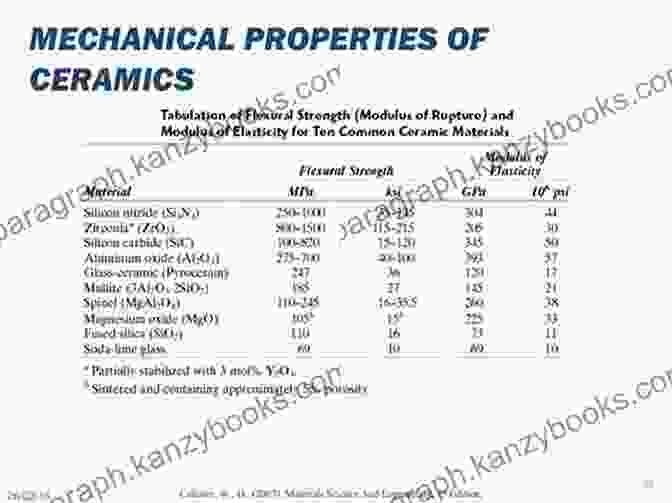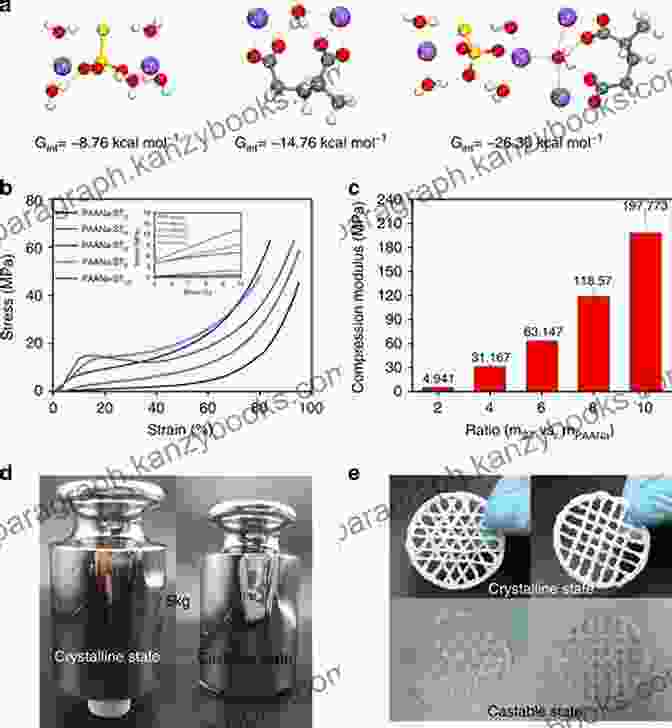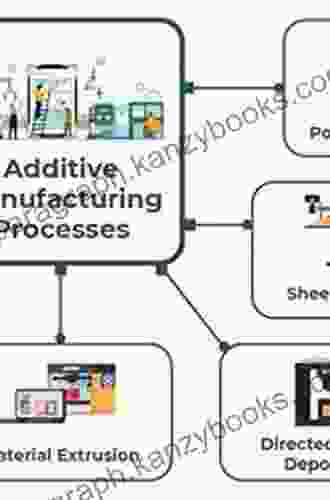Comparative Analysis of Mechanical Properties of Additive Manufacturing Materials

5 out of 5
| Language | : | English |
| File size | : | 307703 KB |
| Text-to-Speech | : | Enabled |
| Enhanced typesetting | : | Enabled |
| Print length | : | 1097 pages |
:
Additive manufacturing, also known as 3D printing, has revolutionized the manufacturing landscape. This transformative technology allows for the production of complex geometries, customized designs, and intricate components with unprecedented precision. At the core of this technological advancement lies the selection of materials that determine the mechanical performance of the resulting parts. This comprehensive analysis aims to shed light on the mechanical properties of various materials employed in additive manufacturing, empowering engineers and designers to make informed choices for their projects.
Mechanical Properties in Focus:
The mechanical properties of materials are crucial indicators of their ability to withstand external forces and stresses. In the context of additive manufacturing, these properties include:
- Tensile Strength: Resistance to breaking under tensile stress
- Yield Strength: Point at which a material begins to deform permanently
- Ductility: Ability to deform under stress before breaking
- Fracture Toughness: Resistance to crack propagation
- Fatigue Strength: Resistance to repeated loading and unloading
Material Categorization:
Additive manufacturing materials encompass a wide spectrum of categories, each with distinct properties:
- Polymers: Thermoplastics and thermosets known for their lightweight, flexibility, and ease of processing
- Metals: Alloys with high strength, stiffness, and thermal conductivity
- Ceramics: Inorganic materials characterized by high hardness, wear resistance, and thermal stability
- Composites: Combinations of different materials to achieve tailored properties
Comparative Analysis:
Polymers:
Polymers, namely thermoplastics like ABS and PLA, offer a balance of strength and flexibility. Their lightweight nature and low cost make them suitable for prototyping and consumer products. However, their mechanical properties are generally lower compared to metals and ceramics.

Metals:
Metals, such as aluminum, titanium, and stainless steel, exhibit superior strength, stiffness, and durability. Their high thermal conductivity also enables efficient heat dissipation. However, metals can be more challenging to process in additive manufacturing due to their higher melting points and potential for defects.

Ceramics:
Ceramics, including zirconia and alumina, possess remarkable hardness, wear resistance, and thermal stability. They find applications in medical implants, cutting tools, and high-temperature environments. However, ceramics are typically brittle and require careful handling during processing and post-processing.

Composites:
Composites combine different materials to achieve tailored properties. For instance, fiber-reinforced polymers enhance strength and stiffness while maintaining lightweight characteristics. Composites offer versatility in design and can be optimized for specific applications.

Factors Influencing Mechanical Properties:
The mechanical properties of additive manufacturing materials are influenced by several factors:
- Printing Parameters: Temperature, layer thickness, and printing speed
- Post-Processing: Heat treatment, surface finishing, and infiltration
- Material Composition: Alloying elements, reinforcement fibers, and additives
- Design Features: Geometry, orientation, and internal structures
Applications and Considerations:
The selection of additive manufacturing materials depends on the specific application and performance requirements. For instance:
- Automotive: Lightweight polymers for interior components, metal alloys for structural parts
- Aerospace: High-strength metals for aircraft components, ceramics for heat-resistant tiles
- Medical: Biocompatible polymers for implants, porous ceramics for bone regeneration
- Consumer Products: Durable plastics for toys, flexible elastomers for wearable devices
:
The comparative analysis of mechanical properties of additive manufacturing materials provides valuable insights for engineers and designers to make informed decisions. By understanding the strengths and limitations of different materials, it becomes possible to optimize designs, improve performance, and push the boundaries of innovation. As additive manufacturing technology continues to evolve, new materials with tailored properties will emerge, further expanding the possibilities for groundbreaking applications.
5 out of 5
| Language | : | English |
| File size | : | 307703 KB |
| Text-to-Speech | : | Enabled |
| Enhanced typesetting | : | Enabled |
| Print length | : | 1097 pages |
Do you want to contribute by writing guest posts on this blog?
Please contact us and send us a resume of previous articles that you have written.
 Book
Book Novel
Novel Page
Page Chapter
Chapter Text
Text Story
Story Genre
Genre Reader
Reader Library
Library Paperback
Paperback E-book
E-book Magazine
Magazine Newspaper
Newspaper Paragraph
Paragraph Sentence
Sentence Bookmark
Bookmark Shelf
Shelf Glossary
Glossary Bibliography
Bibliography Foreword
Foreword Preface
Preface Synopsis
Synopsis Annotation
Annotation Footnote
Footnote Manuscript
Manuscript Scroll
Scroll Codex
Codex Tome
Tome Bestseller
Bestseller Classics
Classics Library card
Library card Narrative
Narrative Biography
Biography Autobiography
Autobiography Memoir
Memoir Reference
Reference Encyclopedia
Encyclopedia Rebecca Fett
Rebecca Fett Jolene Daisy
Jolene Daisy Judy May Murphy
Judy May Murphy Stephanie Marohn
Stephanie Marohn Suzanne Strong
Suzanne Strong Mikal Gilmore
Mikal Gilmore June Cotner
June Cotner John Gray
John Gray Julie Danneberg
Julie Danneberg Terry Hope Romero
Terry Hope Romero Julie Wald
Julie Wald Judith Greif
Judith Greif Justin Ledford
Justin Ledford Julia Schulte
Julia Schulte Jp Herman
Jp Herman Josh Wackler
Josh Wackler Johnny Ball
Johnny Ball Joyce Goldstein
Joyce Goldstein Julie Sizemore
Julie Sizemore Jordan S Josephson
Jordan S Josephson
Light bulbAdvertise smarter! Our strategic ad space ensures maximum exposure. Reserve your spot today!

 Kurt VonnegutUnveiling the Secrets of Love and Desire: "The Song of Songs" and "Song of...
Kurt VonnegutUnveiling the Secrets of Love and Desire: "The Song of Songs" and "Song of...
 Albert ReedUnlock the Joy of Coding: Embark on an Interactive Adventure with "Branches...
Albert ReedUnlock the Joy of Coding: Embark on an Interactive Adventure with "Branches...
 Norman ButlerTaxes for Beginners: A Comprehensive Guide to Understanding Taxes and Why We...
Norman ButlerTaxes for Beginners: A Comprehensive Guide to Understanding Taxes and Why We... Arthur Conan DoyleFollow ·9.3k
Arthur Conan DoyleFollow ·9.3k George OrwellFollow ·14.4k
George OrwellFollow ·14.4k Marcus BellFollow ·11k
Marcus BellFollow ·11k Ismael HayesFollow ·4.4k
Ismael HayesFollow ·4.4k Grayson BellFollow ·12.9k
Grayson BellFollow ·12.9k Jesus MitchellFollow ·3.5k
Jesus MitchellFollow ·3.5k Brenton CoxFollow ·19.4k
Brenton CoxFollow ·19.4k Duncan CoxFollow ·4.7k
Duncan CoxFollow ·4.7k

 Vladimir Nabokov
Vladimir NabokovCapricorn Rising: An Astrological Life
Are you a...

 Jimmy Butler
Jimmy ButlerHis Own Where: A Timeless Masterpiece of American...
An Unforgettable Story of Identity,...

 Gary Reed
Gary ReedFlying the Dragon: A Must-Read for Anyone Interested in...
Natalie Dias...

 Kenneth Parker
Kenneth ParkerFairy Tales For Children Of All Ages: Timeless Stories To...
Fairy tales are...

 Robin Powell
Robin Powell50 Hikes With Kids California: The Ultimate Guide to...
Embark on an...

 Brenton Cox
Brenton CoxUnlock Your Emotional Mastery: Discover the Power of...
Emotions play a pivotal role in our daily...
5 out of 5
| Language | : | English |
| File size | : | 307703 KB |
| Text-to-Speech | : | Enabled |
| Enhanced typesetting | : | Enabled |
| Print length | : | 1097 pages |






